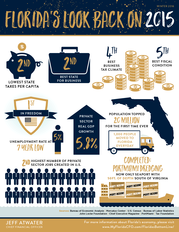Description
FLORIDA’S INTERNATIONAL TRADE
SUMMER 2015
OVER $150 BILLION IN TOTAL INTERNATIONAL TRADE
TOTAL
EXPORTS
$82B
TOTAL
IMPORTS
$72B
Top 3 Export Destinations
ADE IN
M
FL O RI DA
$16 B
BRAZIL
$6 B
COLOMBIA
CHILE
$4 B
1 in every 5 exporting
businesses in the U.S.
are in Florida
Top 3 Manufactured Exports
COMPUTER &
ELECTRONICS
TRANSPORTATION
EQUIPMENT
CHEMICALS
$14 B
$9 B
$7 B
Florida’s exports
support 270,000 jobs
FLORIDA RANKS:
#1 IN EXPORT INTENSITY
#1 EXPORTER TO LATIN AMERICA & THE CARIBBEAN
Florida
exports
45% of what
it produces
#2 LARGEST NUMBER OF EXPORTERS
#3 LARGEST EXPORTER OF HIGH-TECH GOODS
Sources: As of 2014, Enterprise Florida | U.S. Trade Administration
JEFF ATWATER
Jeff Atwater | Chief Financial
CHIEF FINANCIAL OFFICER Officer
For more information about Florida’s economy, please visit
Florida’s Bottom Line 9
www.MyFloridaCFO.com/FloridasBottomLine/
.













